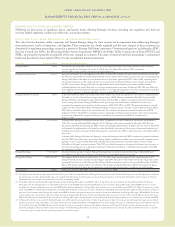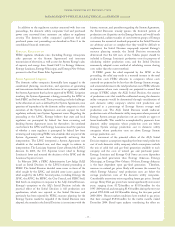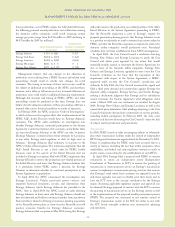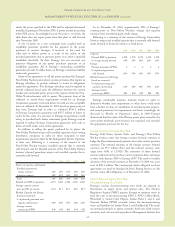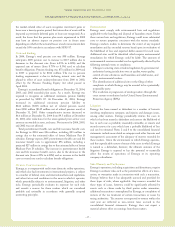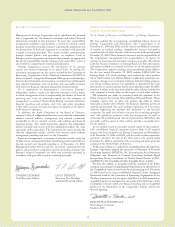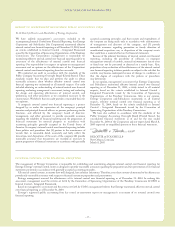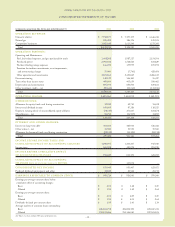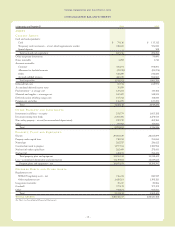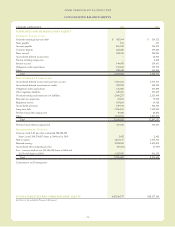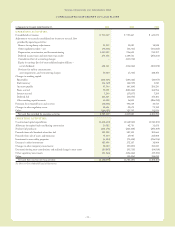Entergy 2004 Annual Report Download - page 44
Download and view the complete annual report
Please find page 44 of the 2004 Entergy annual report below. You can navigate through the pages in the report by either clicking on the pages listed below, or by using the keyword search tool below to find specific information within the annual report.
-42 -
Entergy Corporation and Subsidiaries 2004
States and Entergy’s Non-Utility Nuclear business increased
income by approximately $28.9 million net-of-tax for the excess
of the reduction in the liability over the amount of
undepreciated asset retirement cost at the time of adoption of
SFAS 143. The changes in probability for ANO 1 and ANO 2
had no effect on net income because, as discussed further below,
any amounts recorded related to SFAS 143 are offset by the
recording of regulatory assets or regulatory liabilities when
projected decommissioning costs are collected in rates. Future
revisions to appropriately reflect changes needed to the estimate
of decommissioning costs will affect net income, only to the
extent that the estimate of any reduction in the liability exceeds
the amount of the undepreciated asset retirement cost at the
date of the revision, for unregulated portions of Entergy’s
business. Any increases in the liability recorded due to such
changes are capitalized and depreciated over the asset’s
remaining economic life in accordance with SFAS 143.
•Spent Fuel Disposal -Federal regulations require the U.S.
Department of Energy (DOE) to provide a permanent
repository for the storage of spent nuclear fuel, and legislation
has been passed by Congress to develop this repository at Yucca
Mountain, Nevada. Until this site is available, however, nuclear
plant operators must provide for interim spent fuel storage on
the nuclear plant site, which can require the construction and
maintenance of dry cask storage sites or other facilities. The
costs of developing and maintaining these facilities can have a
significant effect (as much as 16% of estimated decommission-
ing costs). Entergy’sdecommissioning studies include cost esti-
mates for spent fuel storage. However, these estimates could
change in the future based on the timing of the opening of the
YuccaMountain facility, the schedule for shipments to that
facilitywhen it is opened, or other factors.
•Technology and Regulation - To date, there is limited practical
experience in the United States with actual decommissioning of
large nuclear facilities. As experience is gained and technology
changes, cost estimates could also change. If regulations
regarding nuclear decommissioning were to change, this could
have a potentially significant effect on cost estimates. The effect
of these potential changes is not presently determinable.
Entergy’sdecommissioning cost studies assume current
technologies and regulations.
SFAS 143
Entergy implemented SFAS 143, “Accounting for Asset
Retirement Obligations,” effective January 1, 2003. Nuclear
decommissioning costs comprise substantially all of Entergy’s asset
retirement obligations, and the measurement and recording of
Entergy’s decommissioning obligations changed significantly with
the implementationof SFAS 143. The most significant differences
in the measurement of these obligations are outlined below:
•Recording of full obligation - SFAS 143 requires that the fair
value of an asset retirement obligation be recorded when it is
incurred. This caused the recorded decommissioning obligation
in Entergy’s U.S. Utility business to increase significantly, as
Entergyhad previouslyonly recorded this obligation as the
related costs were collected from customers, and as earnings
were recorded on the related trust funds.
•Fair value approach - SFAS 143 requires that these obligations
be measured using a fair value approach. Among other things,
this entails the assumption that the costs will be incurred by a
third party and will therefore include appropriate profit margins
and risk premiums. Entergy’s decommissioning studies had
been based on Entergy performing the work, and did not
include any such margins or premiums.
•Discount rate - SFAS 143 requires that these obligations be
discounted using a credit-adjusted, risk-free rate.
The net effect on Entergy’s financial statements of implementing
SFAS 143 for the U.S. Utility and Non-Utility Nuclear
businesses follows:
•For the U.S. Utility business, the implementation of SFAS 143
for the rate-regulated business of the domestic utility companies
and System Energy was recorded as regulatory assets, with no
resulting effect on Entergy’s net income. Entergy recorded these
regulatory assets because existing rate mechanisms in each
jurisdiction are based on the original or historical cost standard
that allows Entergy to recover all ultimate costs of
decommissioning existing assets from current and future
customers. As a result of this treatment, SFAS 143 is expected
to be earnings neutral to the rate-regulated business of the
domestic utilitycompanies and System Energy. Upon
implementation of SFAS 143 in 2003, assets and liabilities
increased by $1.1 billion for the U.S. Utility segment as a result
of recording the asset retirement obligations at their fair values
of $1.1 billionas determined under SFAS 143, increasing
utility plant by $288 million, reducing accumulated depreciation
by $361 million and recording the related regulatory assets of
$422 million. The implementation of SFAS 143 for the portion
of River Bend not subject to cost-based ratemaking decreased
earnings by $21 million net-of-tax ($0.09 per share) as a result
of a one-time cumulative effect of accounting change. In
accordance with ratemaking treatment and as required by
SFAS 71, the depreciationprovisions for Entergy’s utility
subsidiaries include a component for removal costs that are not
asset retirement obligations under SFAS 143. Approximately
6% of the U.S. Utility’s current depreciation rates, on a
weighted-average basis, represents a component for the net of
salvage value and removal costs.
•For the Non-Utility Nuclear business, the implementation of
SFAS 143 in 2003 resulted in a decrease in liabilities of
$595 million due to reductions in decommissioning liabilities,
adecrease in assets of $340 million, including a decrease in
electric plant in service of $315 million, and an increase in
earnings of $155 million net-of-tax as a result of the one-time
cumulative effect of accounting change.
Also, beginning in 2003, Entergy’s earnings for the Non-Utility
Nuclear business have an increase of $18 million after-tax because
of the change in accretion of the liability and depreciation of the
adjusted plant costs fromthe 2002 levels. This effect will gradually
decrease over future years as the accretion of the liability increases.
Management expects that applying SFAS 143 post-implementation
will have a minimal effect on ongoing earnings for the
U.S. Utility business.
MANAGEMENT’S FINANCIAL DISCUSSION and ANALYSIS continued




